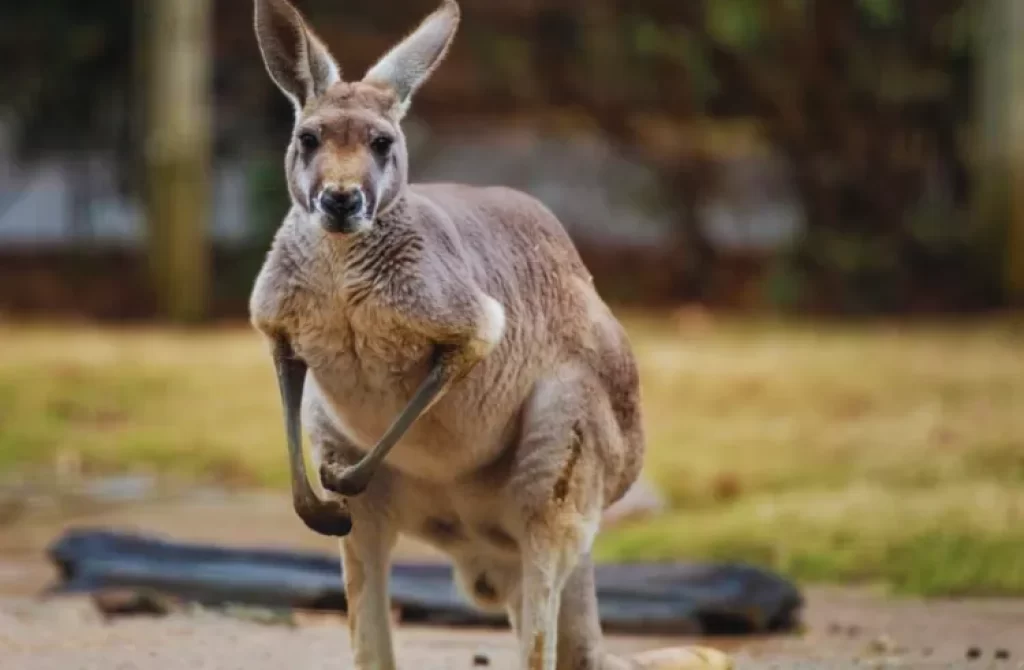Kangaroos, with their unique appearance and captivating behavior, are iconic symbols of Australia’s wildlife. However, many people wonder if these fascinating creatures can be dangerous.
So let’s explore the nature of kangaroos to determine if they pose a threat to humans or other animals. Let’s separate fact from fiction and gain a better understanding of the potential dangers associated with kangaroos. 🦘
Are Kangaroos Dangerous?

Kangaroos can be dangerous in certain situations. While they generally prefer to avoid confrontations, they can deliver powerful kicks and use their claws for self-defense if they feel threatened.
Instances of kangaroo aggression towards humans are relatively rare, but caution should be exercised, especially during mating seasons or when they are cornered. Additionally, road collisions with kangaroos pose a risk. It is important to respect their space and follow safety guidelines to minimize potential dangers.
Kangaroo Behavior and Social Structure
Kangaroos are generally peaceful and prefer to avoid confrontations. They are social animals that live in groups called mobs, consisting of females (called does) and their offspring, along with dominant males (called bucks) who protect the group. Their social hierarchy is based on size, strength, and age.
Defensive Mechanisms
When kangaroos feel threatened, their primary mode of defense is to use their powerful hind legs to deliver strong kicks.
These kicks can cause significant injury to potential predators or threats. Kangaroos also have sharp claws on their forelimbs, which they can use in self-defense if necessary. However, these defensive behaviors are typically directed towards other animals rather than humans.
Risks to Humans
While kangaroos generally prefer to avoid human interaction, there have been instances where kangaroos have behaved aggressively towards humans, especially if they feel threatened or cornered. This is more common during mating seasons when male kangaroos can become more territorial and protective. In such situations, it is essential to give kangaroos space and respect their boundaries to minimize the risk of aggression.
Road Safety
One significant risk associated with kangaroos is road collisions. Kangaroos are known to be active near roadways, particularly during dawn and dusk when visibility is low. These collisions can be hazardous for both humans and kangaroos, leading to property damage, injury, or even fatalities. Drivers in kangaroo-populated areas should exercise caution, adhere to speed limits, and remain vigilant to reduce the risk of accidents.
Disease Transmission
Another potential concern related to kangaroos is the transmission of diseases. While kangaroos themselves do not pose a direct threat in terms of transmitting diseases to humans, they can carry parasites and ticks that may be harmful. It is important to maintain appropriate hygiene practices and avoid close contact with wild kangaroos to minimize the risk of exposure to potential pathogens.
Do Kangaroos Drown People or Prey?

No, kangaroos do not typically drown people or prey. Kangaroos are not aquatic animals and are not adapted for swimming or submerging themselves in water for extended periods.
While they may encounter water bodies, such as rivers or lakes, they do not possess the physical adaptations or predatory behavior to intentionally drown prey or pose a drowning risk to humans. Kangaroos primarily rely on their powerful legs for defense and escape rather than engaging in predatory behaviors associated with drowning.
Do Kangaroos Box or Punch?
Yes, kangaroos engage in a behavior known as boxing, which involves striking with their front legs. Boxing is typically observed during disputes between male kangaroos competing for dominance or during courtship rituals. Kangaroos use their strong arms and sharp claws to swipe at their opponents, aiming to establish dominance or defend their territory.
It is a form of aggressive behavior that allows them to establish hierarchy or protect themselves. However, it’s important to note that boxing is primarily a social behavior among kangaroos and not directed towards humans unless they feel threatened or cornered.
Do female kangaroos fight?
Yes, female kangaroos, known as does, can engage in fighting behaviors, although it is less common compared to male kangaroos. Female kangaroos may fight for various reasons, such as establishing dominance within their social group or protecting their young.
These fights typically involve pushing, grappling, and occasionally kicking, but they are generally less intense than the aggressive bouts observed among male kangaroos.
Female kangaroos may also engage in sparring matches as a way to practice and develop their fighting skills, preparing themselves for potential conflicts with other females or predators.
Do kangaroos fight over females?

Yes, male kangaroos, known as bucks, often engage in fights over females during the mating season. These fights are typically intense and can involve boxing, kicking, and grappling with their opponents. Male kangaroos use their size, strength, and antler-like structures called “chestnuts” to establish dominance and secure breeding rights with females.
The fights can be quite aggressive, with bucks aiming to overpower their rivals and gain the opportunity to mate with receptive females. The winner of the fight gains the right to mate with the female, while the loser is typically driven away. These mating battles are a crucial part of the kangaroo’s reproductive behavior.
Calling all fellow kangaroo enthusiasts! If you, like me, have a deep love for these incredible creatures, you’re in for a real treat. Take a moment to explore this article that delves into the fascinating world of the Red Kangaroo. 🦘
Are male or female kangaroos stronger?

Male Kangaroos, or bucks, are generally stronger and larger than female kangaroos, or does. This sexual dimorphism is common among many marsupial species, including kangaroos. Male kangaroos develop muscular arms and shoulders, which they use for fighting and establishing dominance during mating season. They have larger body sizes and more robust physical features compared to females.
However, female kangaroos are also strong in their own right. They possess strong hind legs used for hopping and can deliver powerful kicks when threatened.
Female kangaroos are responsible for carrying and protecting their young in their pouches, which requires significant strength and endurance.
While male kangaroos may have a greater physical advantage in terms of size and strength, both males and females have adaptations that suit their specific roles and behaviors in the kangaroo’s social structure and ecosystem.
Conclusion
While kangaroos are generally not considered dangerous, they do possess the physical capabilities to defend themselves if they perceive a threat. Instances of kangaroo aggression towards humans are relatively rare and are often the result of feeling cornered or provoked.
By understanding their behavior, respecting their space, and practicing caution, the risk of negative interactions with kangaroos can be minimized. Remember, appreciating these magnificent creatures from a safe distance and observing them in their natural habitat is the best way to enjoy the beauty of kangaroos without compromising safety.
If you want to explore more fascinating information about kangaroos, their behaviors, and their unique adaptations, feel free to check out other articles on our website.







